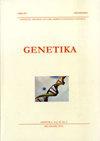马铃薯品种抗黑腿病的比较接种方法
4区 农林科学
Q3 Agricultural and Biological Sciences
引用次数: 0
摘要
为确定马铃薯基因型在离体条件下对萎败乳杆菌黑腿病抗性的最佳接种方法,对5种接种方法进行了比较。用不同的接种方法接种5种马铃薯基因型离体培养的外植体,置于MS固体培养基上,在23?室温,相对湿度70%,光照16小时/天。症状出现后,根据马铃薯基因型(Farmosa、Agria、Picaso、Marfona和野生马铃薯基因型Solanum phureja)的疾病症状严重程度,记录接种方法的效率。用无菌牙签刺冠接种的植株在108 cfu/ml菌悬液中接种,症状最严重。结果表明,品种Marfona的抗性较强,而品种Agria的抗性最强。最后,通过观察不同品种对接种方法的反应,并与前人在温室条件下的抗性评价进行比较,选择108 cfu/ml菌悬液侵染后无菌牙签冠处理作为马铃薯离体抗黑腿病的最佳评价方法。本文章由计算机程序翻译,如有差异,请以英文原文为准。
Comparing inoculation methods for in vitro evaluation of resistance to blackleg disease in potato cultivars
To find the best inoculation method for evaluation of the resistance in potato genotypes against bacterial blackleg caused by Pectobacterium atrosepticum under in vitro conditions, five inoculation methods were compared. In vitro grown explants of five potato genotypes were inoculated with different inoculation methods, then placed on MS solid medium and incubated at 23?C with 70% relative humidity under the light regime of 16 hours a day. After the appearance of symptoms, the efficiency of inoculation methods was then recorded based on the severity of disease symptoms in potato genotypes: Farmosa, Agria, Picaso, Marfona and a wild potato genotype ?Solanum phureja'. Plantlets inoculated by piercing the crown with sterile toothpick inoculated in bacterial suspension of 108 cfu/ml showed the most severe symptoms. Based on all experiments, cultivar Marfona showed higher resistance among all cultivars and, cultivar Agria was the most susceptible. Finally, after witnessing the reactions of different varieties to inoculation methods and comparing them with previous evaluations of resistance in greenhouse conditions, the crown treatment employing sterile toothpick after infection in 108 cfu/ml bacterial suspension was selected and introduced as the best evaluation method of in vitro potato explants against blackleg.
求助全文
通过发布文献求助,成功后即可免费获取论文全文。
去求助
来源期刊

Genetika-Belgrade
AGRONOMY-GENETICS & HEREDITY
CiteScore
1.80
自引率
0.00%
发文量
1
审稿时长
6-12 weeks
期刊介绍:
The GENETIKA is dedicated to genetic studies of all organisms including genetics of microorganisms, plant genetics, animal genetics, human genetics, molecular genetics, genomics, functional genomics, plant and animal breeding, population and evolutionary genetics, mutagenesis and genotoxicology and biotechnology.
 求助内容:
求助内容: 应助结果提醒方式:
应助结果提醒方式:


